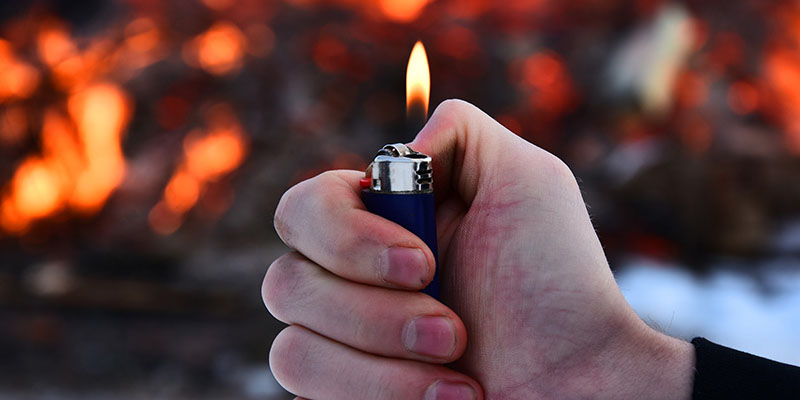Preventing Arson: What’s at Stake?

Arson is the intentional act of setting fire to property. According to the Annual Arson Incident Report from the Bureau of Alcohol, Tobacco, and Firearms, arson fires result in over $1 billion in property damage each year. Most losses occur in the evening or early morning, and the majority start from common ordinary combustibles (USBDC).
The most dangerous arson fires typically start from flammable liquids and gases, which cause almost 40% of all fire-related deaths. Out of 7,039 fires in 2020, 2,903 were started using easily obtained combustibles and 1,744 were started using accelerants (USBDC).
It is common to think damage can only be done to buildings/structures, but arson targets can also include vehicles, watercrafts, dumpsters, forests and more. In fact, some of the largest and most costly arson incidents in history have been from intentional wildfires. In 2016, the Great Smoky Mountains wildfires caused over $2 billion in damages, including the destruction of over 2,000 buildings.
What You Can Do to Help Protect Your Property from Arson?
Arson fires are especially difficult to prevent and mitigate for two reasons. First, incidents tend to occur suddenly with perpetrators that may be unidentifiable due to disguise and/or limited surveillance. Secondly, fires typically spread easily to adjacent buildings, vehicles, trees, etc., essentially providing additional fuel sources that can increase the strength of the fire and the amount of damage.
Organizations should take steps to help protect themselves from arson and prepare to minimize damage if an incident occurs. Below are some practical tips:
Follow Best Practices
- Eliminate and prohibit any unnecessary fuel storage on your property. The most effective risk management strategy is avoidance.
- Remove or protect equipment or materials that can be used as an accelerant. Use locks on equipment, such as fuel tanks or pumps, and store materials in a locked UL-rated anti-flammable cabinet. These should be difficult to access during unsupervised hours.
- Lock large trash cans that contain paper or plastic waste. This can help prevent potentially burning materials from floating or purposefully being thrown into the building.
- Secure all doors, windows, skylights, etc. (including entrances from alleyways), especially in vacant or minimally used buildings.
- Keep the property well-lighted and implement regular landscaping/maintenance to help eliminate unnecessary camouflage or unintentional blocking of security systems.
Establish Training Procedures and Promote a Culture of Safety
- Provide an environment where employees are motivated to embrace risk management and value company property.
- Educate employees by providing basic fire safety training, which should include arson and fire prevention as well as how to properly respond in the event of a fire.
- Establish an emergency evacuation plan to help minimize injury when arson occurs with occupants in the building. Implement regular drills and rehearse the plan.
- Implement training upon hire and on an ongoing basis to formally convey prevention policies, encourage reporting in the event of an incident, and establish investigation procedures.
- Ownership and management should follow news in the region and get involved in the local community to stay informed about arson attacks. Don’t hesitate to report suspicious activity to local authorities and/or request additional patrols in your neighborhood.
Install Proper Equipment
- Install conspicuous and comprehensive video surveillance with monitoring/recording capabilities. Cameras that can be easily seen can provide a deterrent to potential arsonists who fear getting caught.
- Install a central station security alarm with motion detection on windows, doors and other access points.
- Install fire exit doors, preferably self-closing. If they are not self-closing, implement daily checks to ensure they remain closed.
- Install a fire detection system, preferably a central station fire alarm with manual pull stations, hardwired smoke detectors and strobes/horns. This should alert the local fire department when a fire incident is in progress.
- Install a fire suppression system, preferably an automatic sprinkler system, connected to a central fire alarm. Comprehensive sprinkler coverage with central station monitoring is one of the most reliable ways to help protect against fire damage.
Remember that all equipment listed above must be properly maintained by competent parties. Sprinkler systems, for example, require a minimum annual inspection by a professional contractor. Without regular maintenance, the likelihood of a system failure is significantly increased.
Stay Informed
You should also be aware of your local statistics since incident rates can be surprising. Texas (889), Illinois (744) and Florida (683) report the highest number of arson fires, accounting for 33% of the national total (USBDC). Working with your local fire department can help your organization understand the hazards specific to your location. They are often very familiar with the region, including recent events with which you may be unfamiliar.
Sources
https://networkofcare.org/library/CPS%20Arson%20Vand_ADA.pdf
https://w-fp.co.uk/10-ways-to-protect-your-premises-against-arson/
https://www.usfa.fema.gov/downloads/pdf/publications/aaw_contractor_community_handout.pdf









